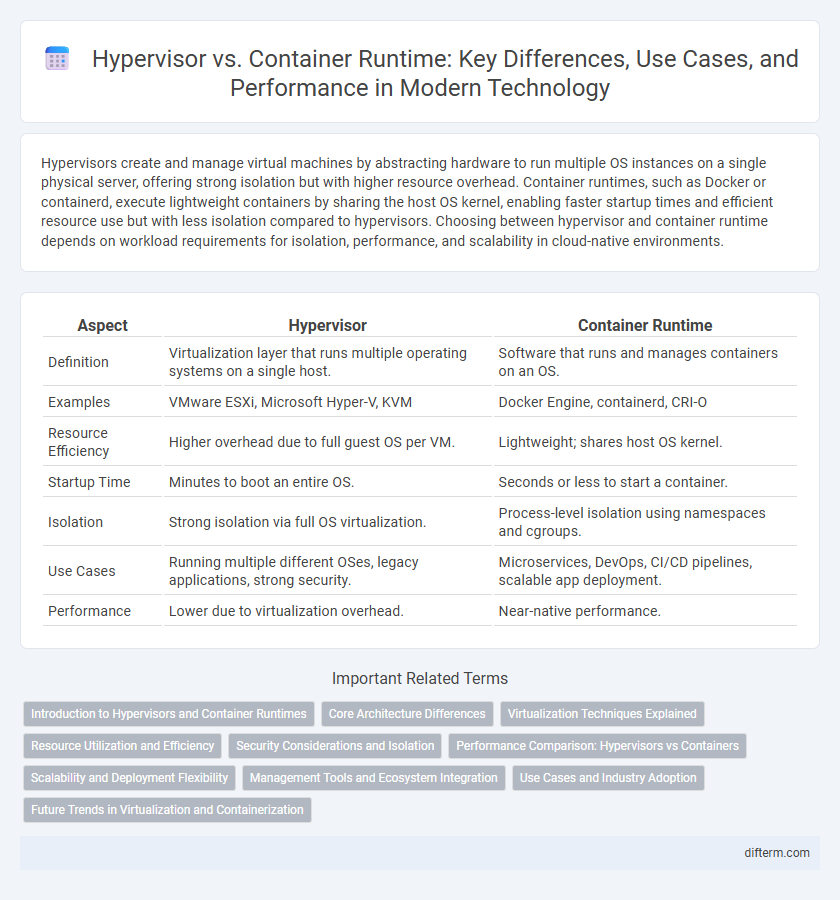Hypervisors create and manage virtual machines by abstracting hardware to run multiple OS instances on a single physical server, offering strong isolation but with higher resource overhead. Container runtimes, such as Docker or containerd, execute lightweight containers by sharing the host OS kernel, enabling faster startup times and efficient resource use but with less isolation compared to hypervisors. Choosing between hypervisor and container runtime depends on workload requirements for isolation, performance, and scalability in cloud-native environments.
Table of Comparison
| Aspect | Hypervisor | Container Runtime |
|---|---|---|
| Definition | Virtualization layer that runs multiple operating systems on a single host. | Software that runs and manages containers on an OS. |
| Examples | VMware ESXi, Microsoft Hyper-V, KVM | Docker Engine, containerd, CRI-O |
| Resource Efficiency | Higher overhead due to full guest OS per VM. | Lightweight; shares host OS kernel. |
| Startup Time | Minutes to boot an entire OS. | Seconds or less to start a container. |
| Isolation | Strong isolation via full OS virtualization. | Process-level isolation using namespaces and cgroups. |
| Use Cases | Running multiple different OSes, legacy applications, strong security. | Microservices, DevOps, CI/CD pipelines, scalable app deployment. |
| Performance | Lower due to virtualization overhead. | Near-native performance. |
Introduction to Hypervisors and Container Runtimes
Hypervisors are virtualization technologies that create and manage multiple virtual machines (VMs) on a single physical host by abstracting hardware resources. Container runtimes, such as Docker and containerd, enable lightweight virtualization by running applications in isolated user spaces sharing the host OS kernel. Both hypervisors and container runtimes optimize resource utilization and deployment efficiency but differ fundamentally in abstraction level and overhead.
Core Architecture Differences
Hypervisors operate by abstracting hardware to create multiple virtual machines, each with its own full operating system, enabling strong isolation but higher resource overhead. Container runtimes leverage OS-level virtualization to run multiple isolated user-space instances, sharing the host kernel for lightweight and efficient deployment. This fundamental architectural difference impacts performance, scalability, and system resource utilization in virtualization environments.
Virtualization Techniques Explained
Hypervisors create and manage multiple virtual machines (VMs) by abstracting hardware resources to run isolated operating systems on a single physical host, enabling robust virtualization with complete OS environments. Container runtimes, such as Docker and containerd, operate at the OS level by sharing the host OS kernel while isolating applications in lightweight containers, optimizing resource efficiency and startup speed. Comparing hypervisor-based virtualization and containerization highlights key differences in isolation, performance, and use cases for deploying scalable cloud-native applications and traditional workloads.
Resource Utilization and Efficiency
Hypervisors virtualize entire hardware environments, enabling multiple operating systems to run on a single physical server but often consuming significant CPU and memory resources due to full OS overhead. Container runtimes, such as Docker and containerd, share the host OS kernel, resulting in lightweight environments with faster startup times and more efficient resource utilization. This efficiency drives higher density deployment on the same hardware, making containers ideal for cloud-native applications and microservices architectures.
Security Considerations and Isolation
Hypervisors provide strong isolation by creating separate virtual machines with dedicated kernels, significantly reducing attack surfaces between environments. Container runtimes share the host operating system kernel, leading to potential vulnerabilities if kernel exploits occur, but they offer lightweight and faster deployment. Security best practices for containers include using minimal base images, runtime security tools, and strict namespace separation to mitigate risks inherent in shared kernel architectures.
Performance Comparison: Hypervisors vs Containers
Hypervisors introduce a performance overhead due to hardware emulation and resource allocation for multiple virtual machines, often resulting in slower I/O and higher latency compared to containers. Containers leverage native OS features and share the host kernel, enabling near-native performance by minimizing overhead and allowing faster startup times and resource efficiency. Benchmark studies consistently show containers outperform hypervisors in CPU, memory, and network throughput under typical workloads.
Scalability and Deployment Flexibility
Hypervisors enable virtual machines with isolated operating systems, providing strong security but higher resource consumption, which can limit scalability in large-scale deployments. Container runtimes use OS-level virtualization to run multiple lightweight containers, offering superior scalability and faster deployment flexibilities, such as rapid scaling and microservice orchestration. Container platforms like Kubernetes enhance deployment flexibility by automating container scaling and management, unlike traditional hypervisor-based setups.
Management Tools and Ecosystem Integration
Hypervisors like VMware ESXi and Microsoft Hyper-V offer comprehensive management tools such as vCenter and System Center Virtual Machine Manager, providing centralized control over virtual machines, resource allocation, and performance monitoring. Container runtimes such as Docker and container orchestration platforms like Kubernetes integrate tightly with CI/CD pipelines, enabling streamlined deployment, scaling, and management of containerized applications across hybrid and multi-cloud environments. Ecosystem integration varies significantly, with hypervisors supporting a broad range of full guest OS workloads, while container runtimes focus on lightweight, portable application environments with rapid lifecycle management and extensive support from cloud-native tools.
Use Cases and Industry Adoption
Hypervisors secure resource isolation by running multiple virtual machines on a single physical server, making them ideal for full OS virtualization in data centers and cloud infrastructure. Container runtimes, such as Docker and containerd, focus on lightweight, portable application deployment and are extensively adopted in microservices architecture and continuous integration/continuous deployment (CI/CD) pipelines across industries like software development and fintech. Enterprises prioritize hypervisors for legacy workloads and multi-tenant environments, while container runtimes dominate cloud-native solutions due to faster startup times, resource efficiency, and scalability.
Future Trends in Virtualization and Containerization
Hypervisor technology is evolving towards lightweight, hardware-accelerated virtualization to improve performance and scalability, while container runtimes are increasingly adopting enhanced security features and support for multi-cloud environments. Emerging trends indicate a convergence between hypervisor capabilities and container orchestration, driven by advancements in Kubernetes and virtualization extensions like AMD SEV and Intel TDX. Future virtualization and containerization will prioritize seamless integration, hybrid cloud deployment, and efficient resource management, shaping the next generation of cloud-native infrastructure.
Hypervisor vs Container Runtime Infographic

 difterm.com
difterm.com